Performance Practice
of Electroacoustic Music
Mesías Maiguashca
The Nagual
The Nagual for metal sound objects (two players) and tape (1993)
Introduction
The Nagual combines amplified acoustic sounds and electronic sounds fixed on tape. It is the last piece of the cycle Reading Castañeda, composed between 1983 and 1993 and produced at ZKM in Karlsruhe, Germany. The Nagual was premiered at ZKM in 1993 within the Festival “Multimediale 3”.
The cycle comprises the pieces The Tonal for sound objects (1993), The Spirit-Catcher for cello and electronics (1992-93), The Wings of Perception I for string quartet and tape (1989), The Wings of Perception II for 8-channel tape (1985/92), Sacateca’s Dance for flute and tape (1985/92), El Oro for flute, cello, tape and narrator (1992), and The Nagual for sound objects and tape (1993). It draws inspiration from the work of the ethnologist and author Carlos Castañeda (1925-1998) and his descriptions of the practice of sorcery among the Yaqui indians in Mexico. Maiguashca was particularly interested in the “descriptions of bizarre, unusual forms of perception” and passages dealing with sound, light, time and space. Maiguashca considers this literature as “perception fiction” to differentiate it from “science fiction”. [Interview, 13:11] The composer did, however, not set out to “musicalise” Castañeda’s texts in these pieces. Rather, they should be understood as “commentaries” or “acoustic reflections” [Maiguashca 1997, p. 9], as “music to be heard during reading pauses of the texts”. [Maiguashca, “Reading Castañeda”]
A defining feature of the cycle is the concept of acoustic and electronic sounds being initiated through a self-made instrument, its development stemming from Maiguashca’s dissatisfaction with the results formerly obtained through sound synthesis based on algorithms. This led him to explore the sonorities of different physical materials and the development and construction of a series of instruments the composer calls sound objects (the acronym KO stands for the German Klangobjekt) the first one using suspended metal objects, later variants integrating wooden objects. This physical sound object triggered the development of a virtual sound object used to produce the synthetic sounds contained on the tape (s. below). The sonorities of the physical objects bear no association with any particular musical language or repertoire. The initial intention was to “understand the vibrating object“ e.g., to find the right conditions to obtain a particular sound with specific objects and playing techniques. The Sound Object was developed initially in cooperation with the student Andrea Atlanti in 1982 when Maiguashca was teaching at the Centre européen pour la recherche musicale in Metz. [Maiguashca 1997a, p.7]. Thereafter he continued the project on his own. The structure consists of a cubic metal frame. The configuration used in The Nagual includes various metal objects such as rods, plates and springs hung by nylon strings on metal horizontal wires attached to each side of the cube.
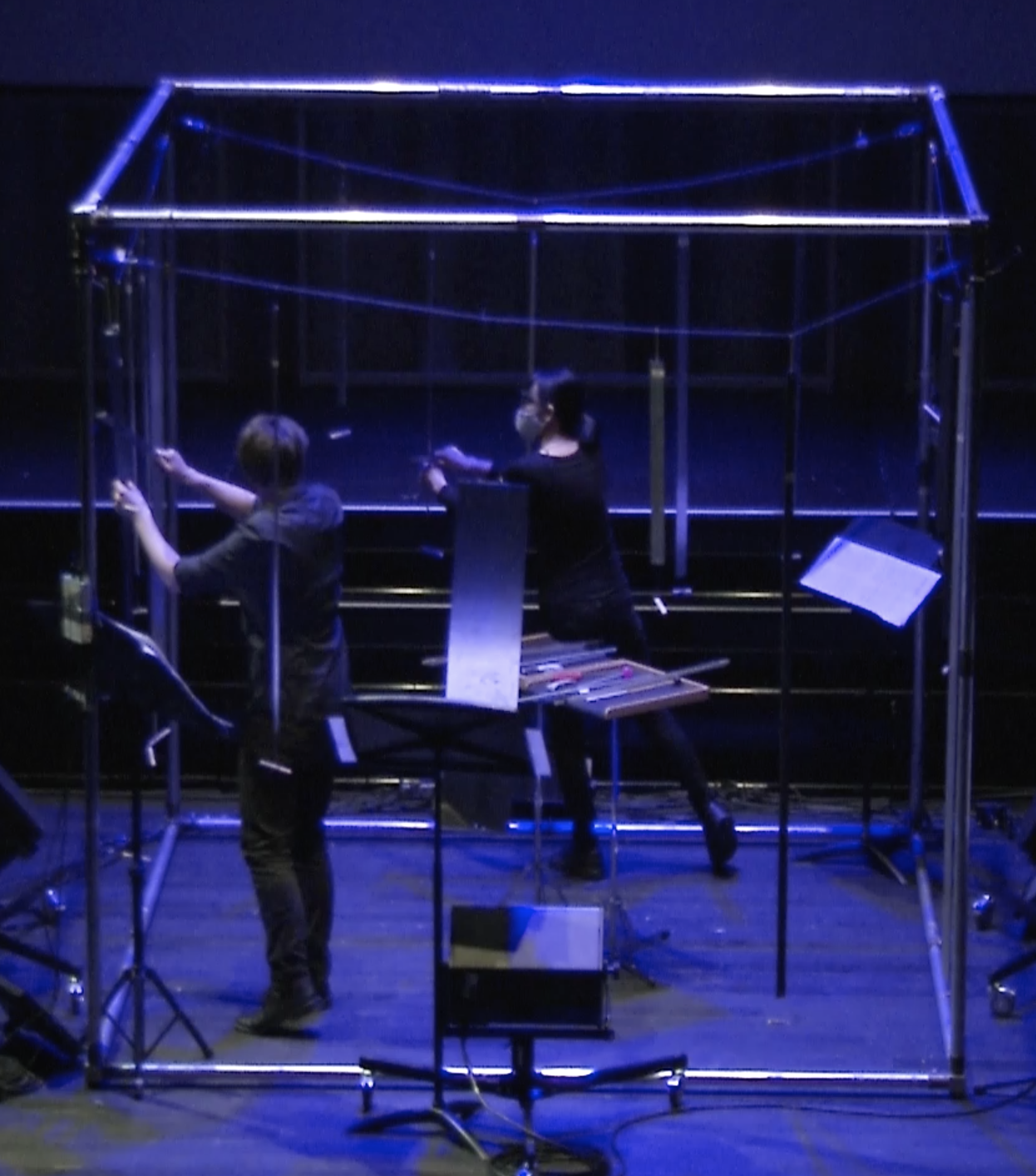
Fig. I. The instrument
The objects are touched, rubbed, hit or played with bows and other objects. A wooden handle attached to the bottom of each object allows to modify the pitch. The nylon strings and the horizontal wires transmit the vibrations of the objects. These signals are then amplified through contact microphones attached to each of the four horizontal wires and directly mapped onto a speaker setup. Maiguashca decided not to process the acoustic sounds in real time, but rather to add to them new sounds created through synthesis, sounds resembling those produced with the metal instruments. He studied their morphology using spectral analysis performed with the applications Chant-Formes, Common Lisp Music and Csound [ibid., p. 15]. For the sound synthesis generation, he designed a virtual sound object in Max. He calls this non-real-time instrument Sound Object Generator [ibid., Abstract] and describes it as follows: “A bank of at least 16 dynamic bandpass filters processes white noise. However, it soon proved very interesting to ‘cascade’ the instrument. This involved using the output of one filter bank as the input to a new filter bank. The first filter bank produces, depending on the parameter ‘bandwidth’, a more or less noisy spectrum with a clearly inharmonic basic structure. The second filter bank ‘plays’ or ‘sings’ with this spectrum.” [ibid., p. 16, s. Fig. II and III] Maiguashca refers to this as “sing-filter”. It was originally controlled with a radio baton. [ibid., p. 32].
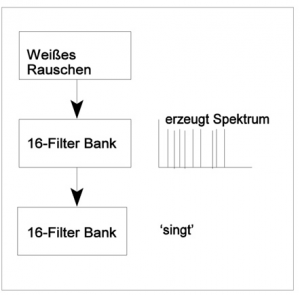
Fig. II. Sound object generator (Klangobjektgenerator) [Maiguashca 1997, p. 16]
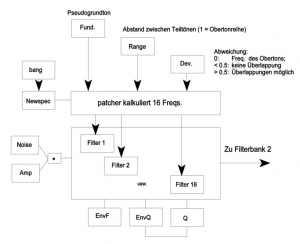
Fig. III. Spectrum generator for The Nagual [Maiguashca 1997, p. 31]
In order to determine the time structure of the tape and the entire composition, Maiguashca designed a time grid of 480 seconds, divided into twenty logarithmically related durations, the longest of which, at 56 seconds, was eight times as large as the smallest, which lasts seven seconds. (A similar approach was used for the pieces The Spirit Catcher and Sacateca’s Dance.) In The Nagual, the series were freely permutated and reordered in four tracks, thus creating a polyphonic structure. [ibid., pp. 33-34, s. Fig. IV and V]

Fig. IV. The Nagual, duration row (Dauernreihe) [Maiguashca 1997], p. 34.

Fig. V. The Nagual, four-track layout [Maiguashca 1997, p. 34]
The exploratory sound production processes involved in the development of the sound object and its virtual correlate is improvisative. Maiguashca had gained experience in this field since working together with Karlheinz Stockhausen from 1968 until 1972, and later with his own group “Oeldorf Gruppe” with Gabriele Schumacher, Péter Eötvös and Joachim Krist.
In The Nagual, the sequences of the performers and their coordination with the tape are described through graphic and symbolic notation. As Maiguashca pointed out during the rehearsals, the score is intended to give suggestions for “a controlled improvisation”. Its model was the score developed for the composition The Tonal written for sound objects and two performers. [cf. Maiguashca 1997b] Similarly, The Nagual defines relational parameters for morphological homogeneity and function (solo/accompaniment) between acoustic and electroacoustic sounds, or between the two players, as well as the degree of variability within a sequence. They are disposed in scales – most of them consisting of five steps –resembling serial organisation principles. Other symbols rule the synchronisation between the three layers and prescribe further qualities such as variation and gradual transformation. The expression marking cantando (“singing”) at the end of the piece asks for subtle melodic phrasing emphasising the resonance rather than the onset.
Reading Castañeda can be considered a key work in Mesías Maiguashca’s artistic development. The reflection on the cultural heritage of the original pre-Colombian American cultures as well as the search for a new sonic language through experimentation with the sound objects proved to be a path to the creation of two large and important works: Boletín y Elegía de las mitas (2006) and La Canción de la Tierra (The Song of the Earth) (2019-20). These works achieve a synthesis of musical traditions of Maiguashca’s native country with an experimental sonic language derived from his experimentation with the sound objects.
Performance Materials
Performance score
Edition Modern 3041
The performance score begins with instructions concerning notation, dynamics, synchronisation, relationship between the two players, descriptions of single events and sequences, explanations about the balance between performers and tape and a description of the click track.
The score is written using space and symbolic notation. Except for the first page, which contains a two-minute introduction without tape, all pages last exactly one minute. In order to perform the required actions and for the performers to coordinate between each other, there is a timeline with equidistant lines below each system. Every ten seconds there is a numerical indicator. A description of the tape is notated above the performers’ parts.
Generally, the notation of The Nagual should be understood as a suggestion for improvisation (the same is true for The Tonal). The sound objects to be used are not defined; rather, the performers should explore different objects in order to find a suitable sound.
Tape
The tape material is provided by the composer. It contains:
– 4 performance audio files, aiff, stereo, 44,1 kHz, 16 bit: Nagual-St1, Nagual-St2, Nagual-St3 and Nagual-St4
– 1 performance click-track audio file, aiff, mono 44,1 kHz, 16 bit: Nagual-Click
– 1 mix audio file for rehearsal, wave, stereo 44,1 kHz, 16 bit: NagualEinspielbandStereo.wav
– 1 click-track audio file for rehearsal, wave, mono 44,1 kHz, 16 bit: NagualClickMono.wav
– 1 text file, docx, with instructions about possible loudspeaker setups and routings: ReadMe.docx
Sound object
The instrument was provided by the composer. The structure consists of a cubic metal frame. Four thin metal cables are spanned horizontally on the upper part of each side, joining the corresponding two supports of each side of the cube. Different metal objects are suspended on each horizontal cable with nylon or other thin cords. A piezo microphone is attached to one end of each horizontal cable, the four signals are then distributed to the speakers in the room.
The objects provided by the composer include seven light metal bars in different sizes, five heavy metal bars in different sizes, four metal tubes in different sizes, two springs in different sizes and one metal plate. The metal objects are numbered and assigned to a specific side of the frame (s. Fig. VI and VII).
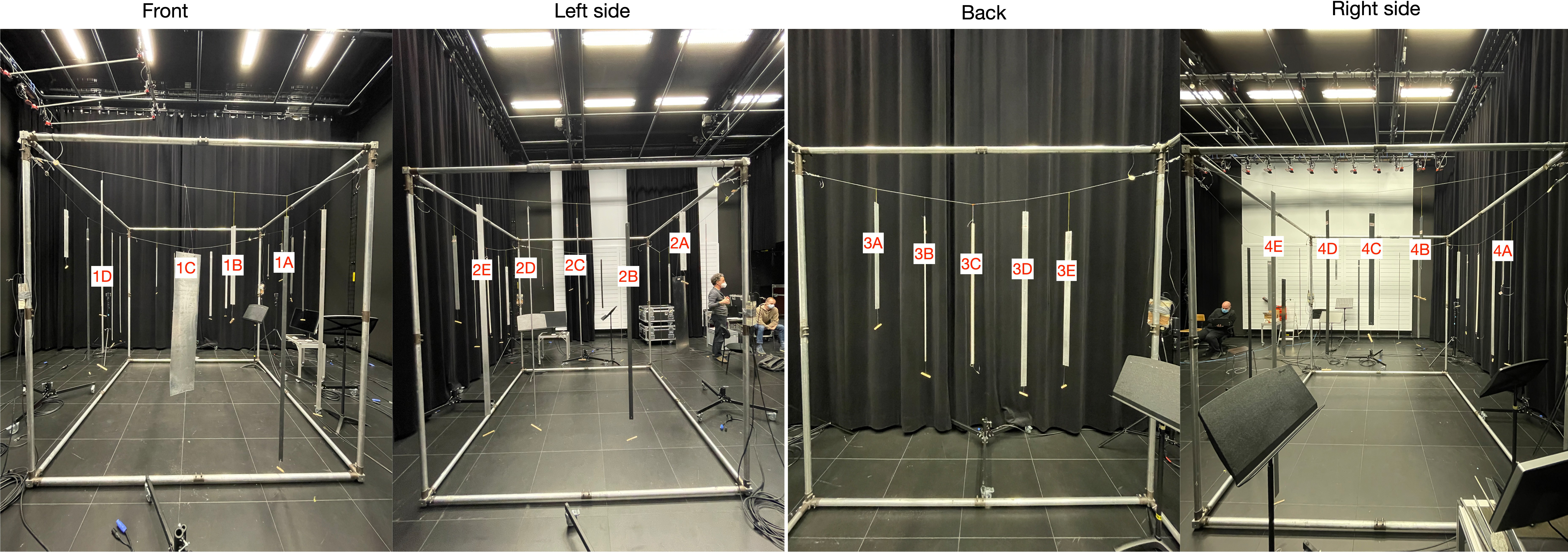
Fig. VI. Metal cube seen from the four sides.
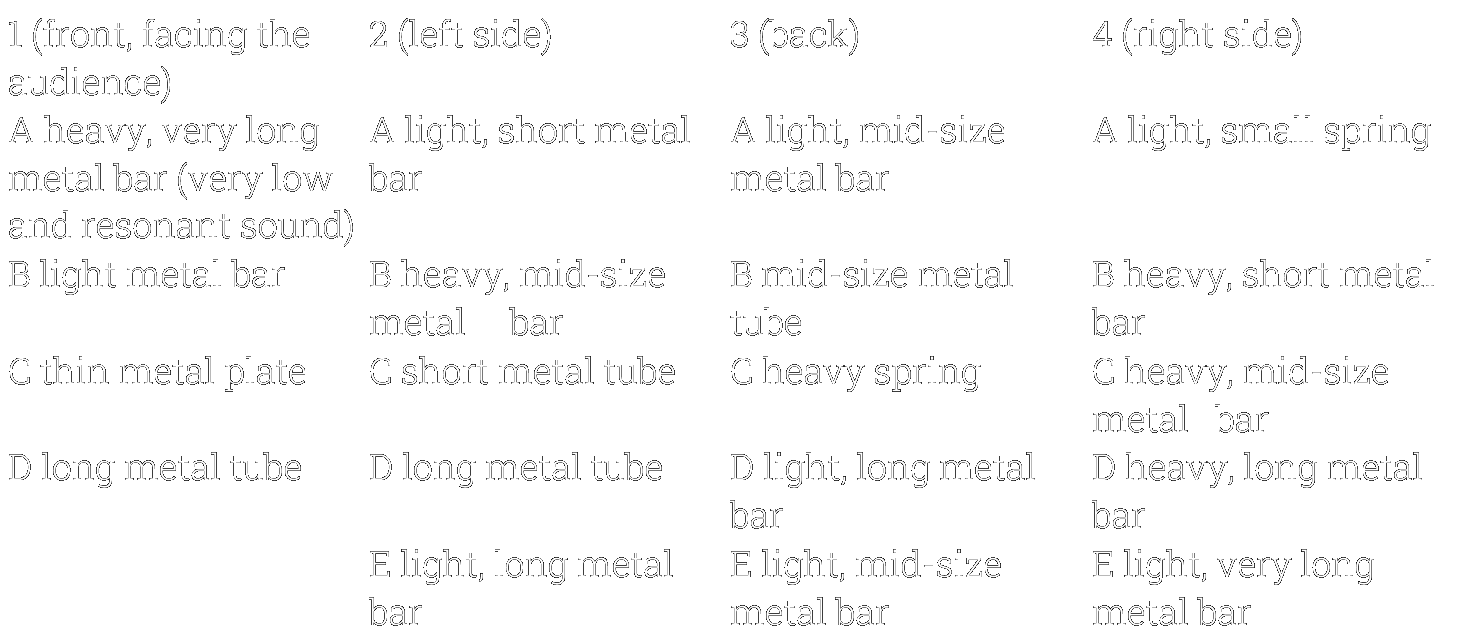
Fig. VII. Distribution of objects.
The first player plays on only two sides of the construction (1 and 2), the second player on the two other sides (3 and 4).
Almost all instruments have an extra nylon cord attached at the bottom with a small piece of wood at the end. By pressing and releasing it, the players are able to modify the pitch, “to sing with it”.
Auctorial Instructions
Playing techniques, instructions in score
The score provides rules to guide the players through the improvisation. The musical actions are notated in measure-like brackets. Each bracket gives information concerning relative durations, dynamics, relationship between the two players, activity, and synchronisation.
Tape
The four upper systems in the score refer to the content of the tape tracks. They include signs for synchronisation through the click track, duration and the expected dynamics of single events on each track.
The click track is indicated in the score with two filled circles (count down) and one empty circle (start).
Output: one possible solution with eight loudspeakers is given as an example in the ReadMe file (s. Sources):
Stereo 1 –> FL-FR
Stereo 2 –> BL-BR
Stereo 3 –> FL-BR
Stereo 4 –> FR-BL
Tape and click track start after an introduction of approx. 30 sec. at rehearsal number 0, time 00,0, on page 2 according to the score.
Performance Report
The concert took place on 28 May 2021 at the main concert hall of ZHdK. Performers were Yukari Yagi and Stefan Bodner, percussion, and Leandro Gianini, sound engineer.
Setup
The cubic metal frame, the metal objects, some beaters, the four piezo microphones and two stereo DI boxes were provided by the composer.
The instrument
Quality and length of the cord connecting the instruments to the horizontal metal cable are important factors. The setup should be done very carefully in order to avoid parasite noises. Some notes:
-For light instruments, the cord should not be too long.
-For heavy instruments the knot on the metal cable should be very tight to prevent any movement, especially when the instruments are placed on the sides of the horizontal cable.
Amplification
For diffusion, eight Kling&Freitag Gravis 12 surrounding the audience, and two Meyer Sound 700-HP subwoofers were used. The signals were fed directly from the piezo to the main PA. Due to the nature of the signal, the sound could be very dynamic and with a very broad frequency range.
Tape & panning
The Reaper DAW was used to play back the tape files. The composer pointed out that the piece has been played with different loudspeaker configurations ranging from stereo to eight-speaker setups. In this performance, an eight-speaker setup was chosen. The routing of the signal is described in the following diagram.
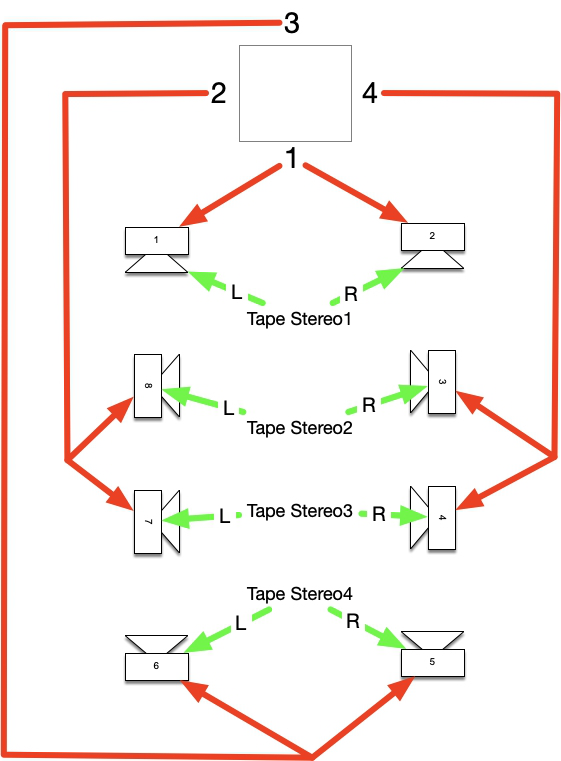
Fig. VIII. Signal routing.
Live sound projection
Once the levels are set during rehearsals, only few manipulations at the FOH are necessary. The musicians themselves control the dynamics. This aspect is very important to the composer; the sound engineer should act as neutrally as possible and leave control over the dynamics to the players. [Interview, 31:50 – 33:55] The sound engineer has four main tasks during the performance: controlling the general dynamic of the performance, balancing the live signal with the tape, starting the tape after the introduction, fading out microphones 1, 2, 3 when the last sound of the piece is produced and then slowly fading out microphone 4.
Monitoring
Four speakers placed on each side of the structure were used for monitoring. The piezos’ signals were directly routed to the monitor placed on the same side. This provided monitoring respecting the actual positions of the instruments and thus better orientation for the musicians.
Synchronisation
The synchronisation between the players and the tape is facilitated by a click track. The players used wireless in-ear phones to listen to the click track. Additionally, a video clock (tape time) was added to facilitate synchronisation during rehearsals and in the performance.
Rehearsals
The score provides no detailed indications about playing techniques. The composer does however have very clear ideas about it. During the rehearsal process he explained and demonstrated the different actions. He divided the actions into three categories: Hitting, scrubbing, or bowing the instrument. These actions can be performed with different kinds of beaters.
Concerning the indication cantando it was decided to generally use the small extra nylon cord and the piece of wood attached to the bottom of the metal objects. This allowed playing with the pitch and the harmonics. For largely improvisational sections the assignment of the instruments and of the beaters was fixed during rehearsals, following suggestions made by the composer. These were very helpful to better integrate the movements from section to section.
Special instruments
Some sound objects have a special character. The composer instructed the musicians on how to treat these.
Player 1
1A: Long metal bar Do not use before 3:56
1C: Thin metal plate Use for the SOLO at 5:30
Player 2
4A Small spring Use for the SOLO at 6:30
During the rehearsals it was remarked that the main beat of the click track was much too loud in relation to the other beats. This proved difficult for the players, as with some lower-quality in-ears it was almost impossible to set an appropriate volume. Therefore, the gain of all the main beats was reduced.
Maiguashca, Mesías (2021): Interview. Conducted by Germán Toro Pérez, 27 September 2021
Maiguashca, Mesías (1997a): “Reading Castañeda”, in: Höldrich, Robert (ed.): Sonderband zur Ringvorlesung «Die Klangwelt am Rand der Datenautobahn», Graz, 1997 (Beiträge zur Elektronischen Musik, 8)
Maiguashca, Mesías (1997b): CD booklet for “Reading Castañeda”, Wergo WER 2053-2 (Edition ZKM, 3)
Maiguashca, Mesías (no date), “37/1993: ‘Reading Castañeda’, ciclo para Instrumentos, Objetos Sonoros y Electrónica”. Online: http://maiguashca.de/es/2021/12/10/37-1993-reading-castaneda-ciclo-para-instrumentos-objetos-sonoros-y-electronica/ [last accessed 14 January 2023]
-last update: 15 November 2023